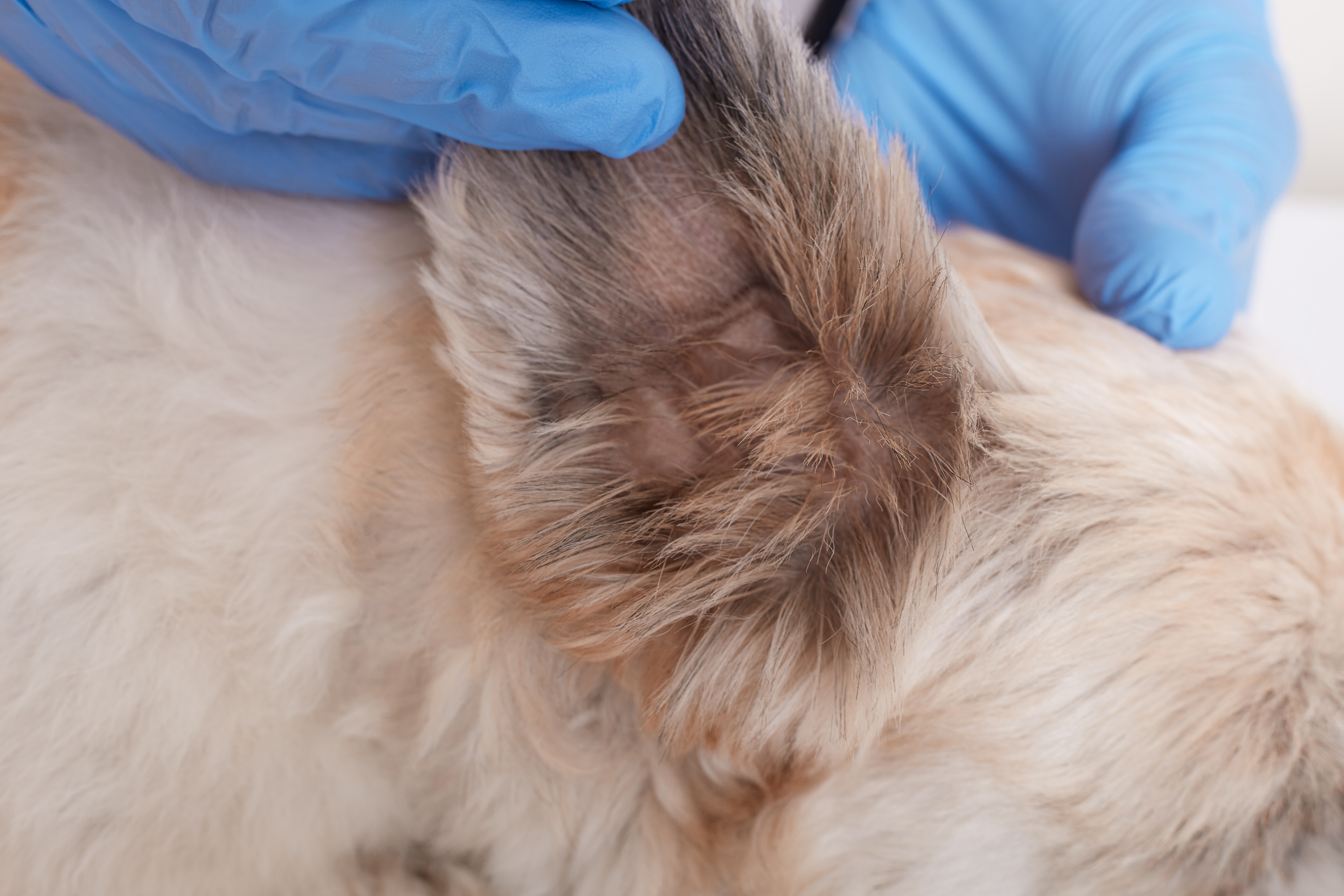One key aspect of keeping your dog healthy and happy is preventative care. While science has created incredible new medications and antibiotics to help treat disease, illness, and infection, nothing is better than keeping your dog from getting sick in the first place.
One of the best ways to keep your dog safe from fleas and ticks is to use monthly preventatives, and here’s what you need to know about these pesky bugs.
Why is flea and tick prevention important? These pests are called “ectoparasites” meaning they live on the outside of their host’s body. Fleas and ticks feed on blood to survive, and must consistently bite their host to draw blood.
A flea and tick infection can directly impact your dog’s health. A flea bite can cause any number of issues, including dermatitis, allergies, anemia, itching, and infections. Tick bites can result in paralysis, abscesses, and even death.
So what is the best way to prevent fleas and ticks from making a home in your dog’s fur, and how can you know what signs to watch out for? Read on to learn everything you need to know about fleas and ticks on dogs.
Signs of Fleas on Dogs
Table of Contents
Intense/Frantic Scratching and Biting
Flea bites, like most bug bites, are itchy and uncomfortable. This can make your pup miserable, forcing them to suddenly start biting and scratching various parts of their body. It might even keep them up at night as they use their paws and teeth in an attempt to find relief.
Use dog flea and tick shampoo to offer them temporary relief. Shampoos and after-bath treatments that are labeled as flea and tick bite relief can help keep them calm until you can take them to see the veterinarian.
Excessive Grooming, Hair Loss
It is natural for dogs to regularly groom themselves, but if those pests start biting and making them miserable, they will groom continuously to stop the itching. Similarly to scratching and biting, your dog might lick or chew the infected spots, causing hair loss or wounds called “hot spots.”
Hot Spots
Many dogs are extra sensitive to flea saliva, causing flea allergy dermatitis. If their skin becomes extra itchy, they might continuously bite or claw at the affected areas, creating hot spots on their neck, flank, or tail. As your dog chews on these hot spots, they might cause worse wounds and infections.
Agitation and Restlessness
You may notice that your dog has undergone some behavioral changes. Sweet and gentle pups can become gloomy, depressed, or manic when they’re dealing with a flea or tick infection. They may become frantic and overly energetic as they look for relief from the itching.
Muscle Loss and Lethargy
Blood loss from flea and tick bites can lead to muscle loss and general lethargy. Anemia can occur if your dog has an infection over a prolonged period, typically seen in puppies and elderly dogs. If your dog is sick or you notice waning health, take them to the veterinarian immediately.
Fur Specks
Fleas aren’t easy to see with the naked human eye, but you might notice “flea dirt” in your dog’s fur. These dark brown specks are flea feces, and you might find them when combing or brushing your dog’s coat. The easiest way to tell if these are flea feces is to put them on a paper towel and mist them with water—if they turn red, it’s flea poop.
Dark Spots In Your Dog’s Bedding
Flea dirt can dislodge from your dog’s fur and fall onto their bedding, causing noticeable dark spots. These spots can even turn red, an obvious sign. You might even see the fleas themselves: tiny reddish-brown insects that move around. If your dog is heavily infested, you might notice the ticks easily. Check your dog’s rump/tail.
Rice Grains On Bedding or Anus
Finally, with a heavy infestation, you’ll see flea eggs. These little “rice grains” will typically be around your dog’s rump or tail, and if you see them squirming in your dog’s feces it’s likely your dog has tapeworms. Tapeworms are part of the flea life cycle, and your dog may develop them after ingesting something they shouldn’t have.
Why Is Flea Prevention Important for Dogs?
Fleas can spread several diseases to dogs, such as:
- Rocky Mountain spotted fever
- Tapeworms
- Babesiosis
- Lyme disease
- Anaplasmosis
- Bartonellosis
- Babesiosis
These diseases can even spread to people, and you must use preventative care and treat your dog for fleas and ticks as soon as possible to keep them out of your home.
How To Get Rid of Fleas on Dogs
The market is filled with products that promise to rid your dog of fleas and ticks. But how many of these products actually work, and which ones are veterinarian-approved? Ridding your dog of an infestation isn’t an overnight process, and there are no miracle cures—a full-blown flea infestation can take weeks or months to treat.
Giving your dog monthly flea and tick preventatives is much easier than getting rid of these pests once they’ve invaded your home.
Flea Comb
Using a flea comb to perform daily checks is a good idea, and this is more involved than regular brushing. By using a fine-toothed metal comb, you can remove any ticks even at their early stages.
It is suggested that you use a flea comb in the bath, to help remove eggs and flea dirt and immediately wash them down the drain. Stroke your dog’s coat a couple of times with the comb and then dip the comb in soap water to shake free anything you’ve removed.
Serious, full-blown infestations require continued sessions with a flea comb so that you can rid your pup of any eggs. Remind yourself to do daily flea checks by using a phone alarm, and ask your veterinarian if you have questions about a regular preventative schedule.
Topical Flea Medications
There are several topical medications designed to kill the fleas living in your dog’s coat. Your veterinarian can help recommend a few different medications, depending on the needs of your dog. These medications are administered in several different ways, and some offer additional protection against heartworm, hookworm, and tapeworm.
Oral Flea Medications
Many veterinarians will tell you that flea prevention for dogs medication is THE way to treat dogs for fleas. Many medicines come in chewable tablets, and when put in a dog treat, will work within half an hour of administration. Monthly preventative products such as Bravecto for dogs will keep fleas from returning, and provide additional protections against tick-borne illnesses.

Dog Flea Shampoo and Sprays
Flea shampoos and sprays can help get an active flea problem under control. While these are typically used to offer relief against scratching and itching, you can use flea shampoos and a flea comb to help remove any visible flea dirt or eggs.
There are active ingredients in these shampoos and sprays designed to kill parasites instantly, but they don’t provide lasting protection. You need to use these productions in conjunction with prescription-strength oral flea medication.
When to See a Veterinarian
While fleas aren’t a medical emergency, and you might be able to rid them without seeing your vet, it’s still a good idea to contact your veterinarian for help. By using prescription medications, oral and topical treatments, flea shampoos, and a flea comb, you can get the infestation under control.
You should contact your veterinarian if you notice:
- Lethargy
- Sudden loss of weight
- Your dog scooting across the floor
- Tapeworm segments in their stool
- Pale gums
The sooner you contact your veterinarian, the sooner you can restore your dog’s quality of life. Paoli Vetcare’s expertise in diagnosing and treating flea infestations in dogs is second to none. By utilizing a comprehensive approach that includes personalized advice, prevention, and ongoing care, Paoli Vetcare can keep your dogs flea-free.
With decades of experience caring for dogs and studying preventative medicine, Paoli’s veterinarians know how to give your pet the best life possible.








